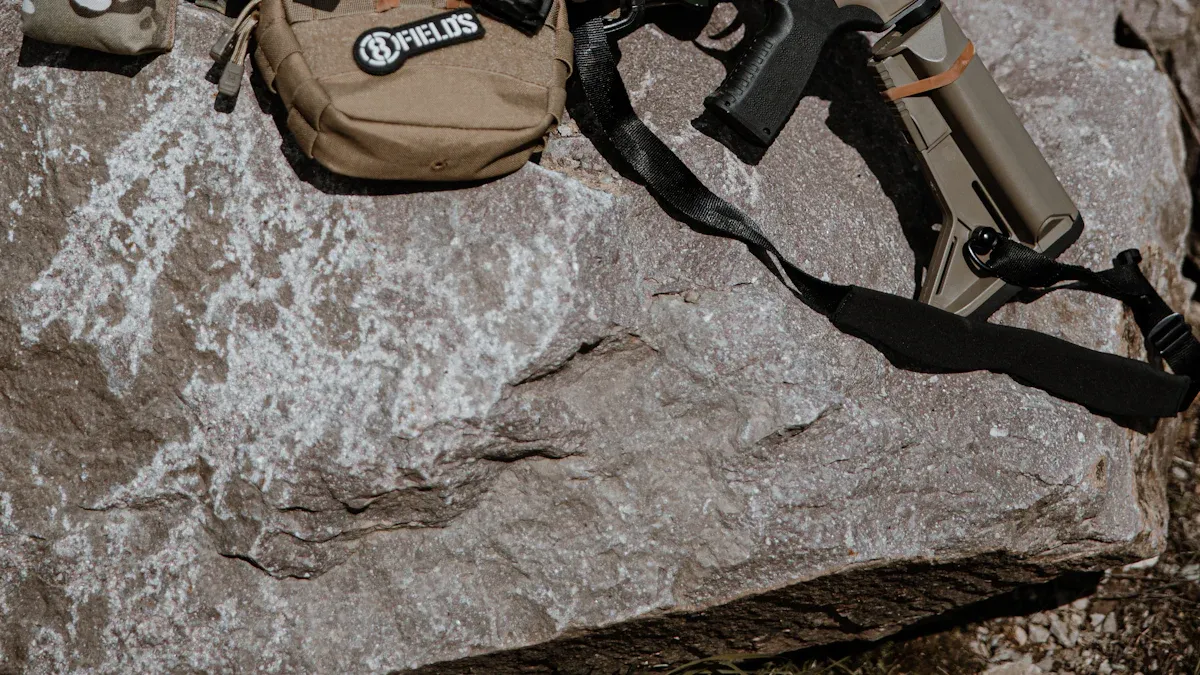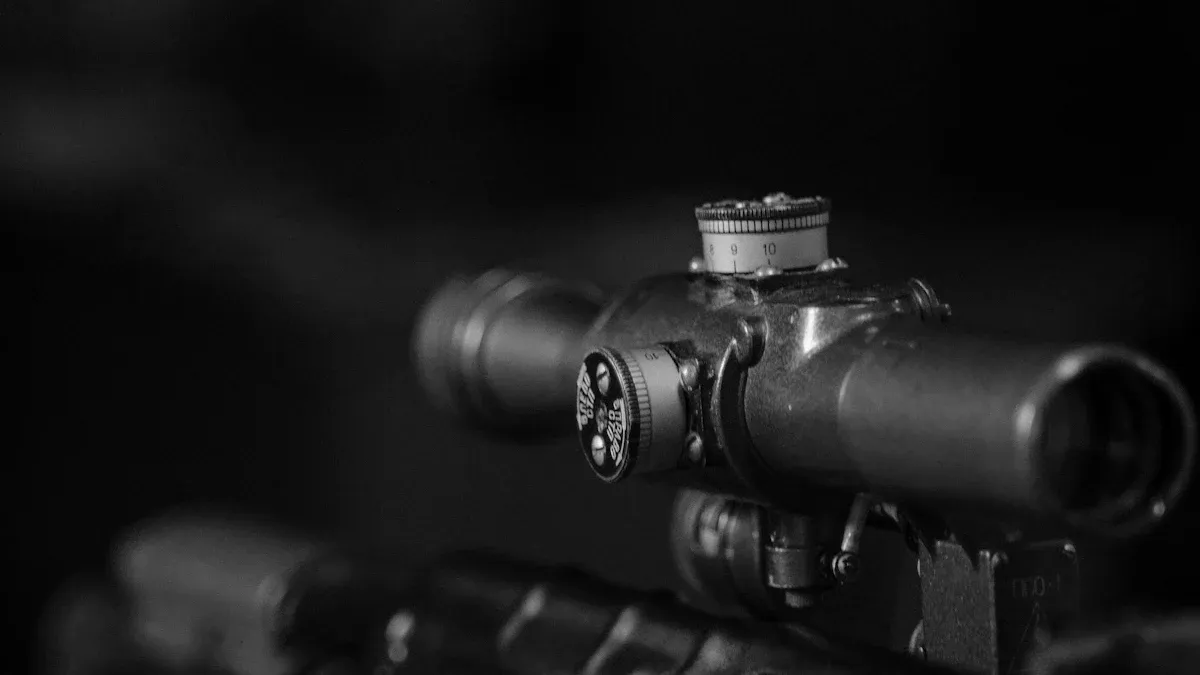
A rifle scope is the unsung hero of precision shooting. Without proper care, it can quickly lose its edge, turning a sharpshooter’s dream into a blurry nightmare. Regular maintenance keeps the lenses clear, the turrets smooth, and the mount secure. Beginners often worry about complex cleaning routines. However, with the right tools and a few simple steps, anyone can keep their scope and rail in top shape. Even the smallest accessories, like lens caps, play a big role in long-term durability.
Think of your rifle scope as a loyal companion—it deserves a little TLC to perform its best every time.
Key Takeaways
- Clean lenses with a microfiber cloth. It clears smudges safely and keeps your view sharp.
- Spray lens cleaner on the cloth, not the lens. This avoids water damage and streaks.
- Check and clean turrets and battery compartments often. Ignoring them can cause problems later.
Tools for Cleaning a Rifle Scope

Keeping a rifle scope in pristine condition starts with the right tools. Each tool plays a unique role in ensuring the scope remains clear and functional. Let’s dive into the essentials.
Microfiber Cloth for Lenses
A microfiber cloth is a must-have for cleaning lenses. It gently removes smudges and fingerprints without scratching the surface. Cleaning kits often include these cloths because they effectively eliminate dust and grime. Studies show that regular use of microfiber cloths enhances visual performance, delivering sharper images. Pro tip: Always keep one in your gear bag for quick touch-ups.
Lens Cleaner for Smudges
Smudges can ruin a perfect shot. A lens cleaner, specifically designed for optics, dissolves oils and dirt without leaving streaks. Spray the cleaner onto the microfiber cloth, not directly on the lens, to avoid damage. This simple step ensures a crystal-clear view every time.
Lens Brush or Air Blower for Dust
Dust particles can be stubborn. A lens brush or air blower removes them without scratching the lens. Many professional shooters swear by air blowers for their speed and effectiveness. They’re also great for clearing moisture, making them a versatile addition to your cleaning kit.
Q-tips for Hard-to-Reach Areas
Some spots on a rifle scope are tricky to clean. Q-tips come to the rescue here. Dipped in isopropyl alcohol, they lift dirt from crevices without scratching. Users often pair them with compressed air to tackle even the most stubborn grime.
Optional Accessories (e.g., Protective Gloves)
Protective gloves keep fingerprints off the lenses during cleaning. They also prevent oils from your hands from transferring to the scope. While optional, they’re a handy addition for meticulous cleaners.
A well-maintained rifle scope isn’t just about aesthetics—it’s about performance. These tools ensure your scope stays in top shape, ready for action.
Rifle Scope Cleaning Process

Dusting the Exterior
Dust can sneak into every nook and cranny of a rifle scope, dulling its shine and performance. Start by using a soft lens brush or compressed air to gently remove debris from the exterior. Avoid rubbing the surface directly, as this might push dirt deeper into crevices. For stubborn spots, a microfiber cloth works wonders. Keep the lens caps on during this step to shield the lenses from accidental scratches or solvent splashes.
Tip: Always dust your rifle scope after outdoor use to prevent buildup that could affect its functionality.
Cleaning the Lenses Safely
Crystal-clear lenses are the heart of a rifle scope. Begin by blowing away loose particles with compressed air or a lens brush. Next, dampen a microfiber cloth with eyeglass cleaner or isopropyl alcohol and wipe the lenses in a circular motion. This technique minimizes streaks and ensures a flawless view. Never spray cleaner directly onto the lens—it risks moisture damage.
- Pro tip: Keep lens covers on when not in use to prevent dirt accumulation.
Maintaining the Turrets
Turrets play a crucial role in precision shooting, yet they often get overlooked during cleaning. Unscrew them carefully and use a Q-tip wrapped in a microfiber cloth to clean the threads and surrounding areas. This prevents dirt from interfering with adjustments.
“Holding is always more accurate than dialing. A friend with a doctorate in optics agrees with me on this. Quality reticles are CNC laser etched. In testing, the turret has been proven not to track perfectly all the time.”
Reliable turret maintenance ensures consistent zeroing, even through multiple iterations.
Inspecting and Cleaning the Battery Compartment
For scopes with illuminated reticles, the battery compartment deserves special attention. Dirt and moisture can lead to corrosion, compromising performance. Remove the battery and inspect the compartment for debris. Use a dry microfiber cloth or a Q-tip dipped in isopropyl alcohol to clean it thoroughly.
Note: Regular inspection prevents unexpected failures during critical moments.
Final Inspection and Wipe Down
Before declaring your rifle scope ready for action, perform a final inspection. Check for missed spots, smudges, or dust. Wipe down the entire scope with a clean microfiber cloth, ensuring every surface gleams. This step not only enhances aesthetics but also guarantees optimal performance.
Reminder: Keep a cleaning kit handy for unexpected cleaning needs during outdoor adventures.
Mistakes to Avoid When Cleaning a Rifle Scope
Spraying Cleaner Directly on the Lens
Spraying cleaner directly onto the lens might seem convenient, but it’s a recipe for disaster. The liquid can seep into the seals, causing long-term damage. Over time, this can lead to fogging or even lens misalignment. Instead, always spray the cleaner onto a microfiber cloth before wiping the lens. This method protects the lens and ensures a streak-free finish.
- Risks of spraying directly:
- Damage to seals, leading to moisture intrusion.
- Increased risk of scratches from debris mixing with the liquid.
- Compromised clarity, which is critical for accurate targeting.
Tip: A clear lens is the key to success in hunting. Protect it by using quality cleaning products and proper techniques.
Using Harsh or Abrasive Materials
Using a shirt tail or paper towel might seem harmless, but these materials can scratch the lens coating. Even small scratches can distort your view, making precision shooting nearly impossible. Stick to soft microfiber cloths or lens brushes designed for optics.
- Common mistakes:
- Using rough fabrics or tissues.
- Ignoring the importance of lens-safe materials.
Reminder: Keeping lens caps on during storage and cleaning prevents accidental contact with abrasive surfaces.
Over-Cleaning the Scope
While regular cleaning is essential, overdoing it can cause more harm than good. Excessive cleaning wears down protective coatings and increases the risk of accidental damage. Clean your scope only when necessary, such as after outdoor use or exposure to harsh conditions.
Pro Tip: Experts recommend cleaning your scope every six months unless it’s exposed to extreme dirt or moisture.
Neglecting the Turrets and Battery Compartment
Turrets and battery compartments often get overlooked, but neglecting them can lead to serious issues. Dirt buildup in the turrets can cause inaccurate adjustments, while a dirty battery compartment may result in corrosion or power failure.
- Real-world examples:
- A Leupold V-series scope had a turret fall off due to poor maintenance.
- A Bushnell scope experienced fogging from a leaky seal in the battery compartment.
Note: Regularly inspect and clean these areas to avoid performance problems.
Skipping Regular Maintenance
Skipping maintenance might save time in the short term, but it can cost you accuracy and performance. Studies show that ignoring scope cleaning can reduce precision by 15% over a year. On the flip side, 70% of users report improved accuracy with regular upkeep.
- Benefits of regular maintenance:
- Clearer vision, as reported by 3 out of 5 marksmen.
- Consistent performance, even in challenging conditions.
Advice: Make scope cleaning a habit. A little effort goes a long way in preserving your gear.
Storing Your Rifle Scope Properly
Proper storage is the unsung hero of rifle scope maintenance. Even the most meticulously cleaned scope can suffer if stored incorrectly. Here’s how to keep it safe and sound.
Use Lens Caps for Protection
Lens caps are the first line of defense for your scope. They shield the lenses from dust, dirt, and accidental scratches. High-quality optics demand this level of care to maintain their performance. Without lens caps, debris can accumulate, leading to visibility issues and potential damage during cleaning. Protecting the lenses ensures they stay pristine and ready for action.
Tip: Always replace the lens caps immediately after cleaning or use. This simple habit can save you from costly repairs.
Store in a Dry, Secure Location
Moisture is a silent enemy. A cool, dry place with consistent temperature and low humidity is ideal for storage. This prevents condensation, which can lead to fogging or internal damage. Always store the scope flat in a secure spot to avoid accidental falls or pressure on delicate components.
- Checklist for optimal storage:
- Cool, dry environment.
- Consistent temperature.
- Flat, secure placement.
Avoid Extreme Temperatures and Humidity
Extreme weather conditions can wreak havoc on your scope. Freezing temperatures may cause thermal stress, leading to cracks or condensation. On the other hand, high heat can degrade lens coatings and misalign internal components. Humidity adds another layer of risk, creating fogging and potential internal damage.
Fact: High humidity can reduce a scope’s lifespan by up to 30%. Avoid storing it in basements or attics where temperature and humidity fluctuate.
Keep Away from Dust and Moisture
Dust and moisture are relentless foes. Before storing, use a soft brush or cloth to remove any dust. This prevents particles from scratching the lenses or settling into crevices. Moisture, even in small amounts, can lead to corrosion over time. A storage bag or case adds an extra layer of protection against these elements.
Pro Tip: Silica gel packets are a great addition to your storage setup. They absorb moisture and keep your scope dry.
Use a Padded Case for Transport
Transporting your scope without proper protection is a recipe for disaster. A padded case cushions it from bumps and drops, ensuring it stays in perfect condition. These cases also shield the scope from dust and moisture during travel. Whether heading to the range or the field, a padded case is a must-have accessory.
Real-world example: A hunter once dropped his scope during transport. Thanks to a padded case, it survived without a scratch, saving him hundreds in repairs.
A rifle scope is more than just a tool; it’s a trusted partner in every shot. Regular cleaning and proper storage ensure it stays reliable and ready for action. Following these simple steps keeps the scope in excellent condition, enhancing both its performance and lifespan. Treat it well, and it will never let you down.
FAQ
How often should a rifle scope be cleaned?
Clean the scope after every outdoor use or exposure to dirt and moisture. For regular maintenance, a thorough cleaning every six months works well.
Tip: Frequent cleaning prevents buildup and ensures peak performance.
Can household cleaning products damage a rifle scope?
Yes, they can. Harsh chemicals or abrasive materials may ruin lens coatings or seals. Always use products specifically designed for optics to avoid costly mistakes.
What’s the best way to prevent fogging inside the scope?
Store the scope in a dry, temperature-controlled environment. Use silica gel packets to absorb moisture. This simple step keeps internal fogging at bay.
Example: A hunter avoided fogging issues by storing his scope with silica gel in a padded case.
Post time: Apr-11-2025
